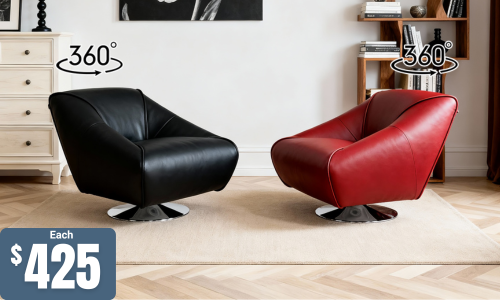Posts tagged with 'home styling'

Creating a home that feels uniquely yours often involves blending different furniture styles. While it may seem daunting, mixing and matching styles can result in a harmonious and personalised space that reflects your taste. Here’s your guide to mastering the art of mixing furniture styles like a pro:
Start with a Dominant Style
Choose a primary style to set the tone for your space. This will act as the foundation upon which you can layer other styles. A dominant style creates cohesion and prevents the design from feeling chaotic. For example, if you love modern design, let clean lines and neutral tones dominate while introducing accents from other styles. This approach ensures that your space has a clear aesthetic direction, making it easier to experiment with additional elements.
Pro Tip: Stick to a 70-30 rule, where 70% of the space adheres to the dominant style, and the remaining 30% is for complementary styles.
Find a Unifying Element
To blend multiple styles seamlessly, identify a common thread that ties them together, such as colour, material, or texture. A unifying element ensures the different styles don’t clash but complement each other. For example, pair a rustic wooden dining table with contemporary chairs, using a shared neutral colour palette to unify the look. This shared feature creates a visual link between pieces, making the combination appear intentional and balanced.
Pro Tip: Consider using accent cushions, throws, or artwork that incorporate colours or materials from both styles to further strengthen the connection.
Play with Proportions
Experiment with scale and balance to avoid one style overpowering another. Proportions ensure visual harmony, even when styles differ. For instance, combine a sleek mid-century modern sofa with a chunky vintage coffee table for an eye-catching contrast. Balancing the visual weight of pieces allows you to mix styles without creating a jarring effect.
Pro Tip: Use symmetry to create balance. For example, if one piece is oversized, balance it with multiple smaller items that share similar design elements.
Use Accent Pieces Strategically
Incorporate smaller furniture or decor items to introduce a secondary style without overwhelming the space. Accent pieces add personality and flair without disrupting the primary aesthetic. A minimalist room can benefit from a bold, bohemian rug or an ornate vintage mirror. These accents can serve as conversation starters while adding depth to the design.
Pro Tip: Limit bold accent pieces to one or two per room to maintain a cohesive look and prevent visual clutter.
Embrace Contrasts
Don’t shy away from mixing contrasting styles—this creates dynamic and intriguing spaces. Contrasts bring energy and depth to a room, preventing it from feeling too uniform. Pair industrial metal bar stools with a classic marble countertop for a striking juxtaposition. The interplay of different styles can make the space feel vibrant and alive.
Pro Tip: Use lighting to highlight contrasts. Position spotlights or pendant lights to draw attention to the contrasting elements and emphasise their uniqueness.
Layer Textures and Materials
Mix textures like wood, metal, glass, and fabric to create a rich and inviting atmosphere. Layering adds dimension and makes the space feel thoughtfully curated. Combine a plush velvet armchair with a rugged leather sofa and a sleek glass coffee table. This mix not only elevates the room’s visual interest but also enhances its tactile appeal.
Pro Tip: Incorporate natural elements like plants or woven baskets to soften the look and make the space feel more grounded and welcoming.
Trust Your Instincts
Ultimately, your home should reflect your personality and preferences. Trust your gut when blending styles. Your intuition ensures the space feels authentic and personal. If it looks and feels right to you, it works—don’t be afraid to break conventional design rules. Remember, your space is a reflection of you, so let it tell your unique story.
Pro Tip: Keep experimenting until you find the right mix. Trial and error often lead to the best results and unexpected design successes.
Mixing and matching furniture styles is an exciting way to showcase your creativity and individuality. By following these tips, you can create a cohesive yet eclectic space that feels truly yours. Ready to start your design journey? Explore our diverse furniture collections today!

A popular trend seamlessly blends the old and the new in the field of interior design - mixing vintage and modern furniture. This delightful combination creates a timeless and eclectic look that adds character and charm to any living space. In this blog article, we will explore the art of blending vintage and modern pieces to achieve a harmonious balance that showcases your unique style while creating a warm and inviting atmosphere in your home.
Embrace the Contrast
One of the key principles of successfully mixing vintage and modern furniture is to embrace the contrast between the two styles. Modern furniture is characterised by clean lines, minimalism, and sleek designs, while vintage furniture often boasts ornate details, classic silhouettes, and rich textures. Instead of attempting to match everything perfectly, celebrate the differences and let them complement each other.
For instance, pairing a contemporary leather sofa with an intricately carved antique coffee table creates a striking visual juxtaposition that captivates the eye. The contrasting elements highlight the individual beauty of each piece, making the entire room more visually engaging.
Focus on Cohesive Colours
While you celebrate the contrast in styles, maintaining a cohesive colour palette is essential for a harmonious look. Choose a colour scheme that unifies the space and ties together the vintage and modern elements. Neutral tones, such as whites, greys, or earthy hues, can serve as a backdrop for both styles, allowing each piece to stand out without clashing.
Incorporate accent colours strategically to add depth and character to the room. For instance, cushions, rugs, or artwork can introduce pops of colour that enhance the overall design while bridging the gap between vintage and modern elements.
Balance Proportions
Proportion is crucial when mixing furniture styles. Be mindful of the scale of each piece to ensure they work well together. If you have a large vintage cabinet, balance it with a modern sofa or chairs of a similar visual weight. Avoid overcrowding the space with too many bold pieces from either style, as this can lead to a cluttered and overwhelming look.
Consider the layout of the room and the flow of movement. A well-balanced combination of vintage and modern pieces will create a space that feels inviting and comfortable while highlighting the uniqueness of each furniture style.
Create a Focal Point
A focal point in the room can tie the vintage and modern elements together effortlessly. It could be a standout vintage piece, such as an antique chandelier or an art deco mirror, or a modern statement piece, like a contemporary sculpture or an eye-catching rug. Let this focal point guide your design choices and help blend the different styles seamlessly.
Tell a Story with Accessories
Accessories play a significant role in tying vintage and modern furniture together. Display meaningful and personal items, such as family heirlooms, vintage photographs, or modern sculptures, to create a narrative that connects the past and the present. These personal touches infuse your living space with your unique history and personality, making it feel like a truly curated and cohesive home.
Mixing vintage and modern furniture is a captivating design approach that allows you to showcase your creativity and create a space that transcends time. Embrace the contrast between the two styles, focus on cohesive colours, and balance proportions to achieve a harmonious look. By creating a focal point and incorporating meaningful accessories, you can weave a story that connects the vintage and modern elements, resulting in a timeless and eclectic living space that reflects your distinctive taste and style. So, go ahead and embark on the journey of blending the old with the new, and let your home become a masterpiece of vintage and modern fusion.




.jpeg)

 (3).jpeg)
